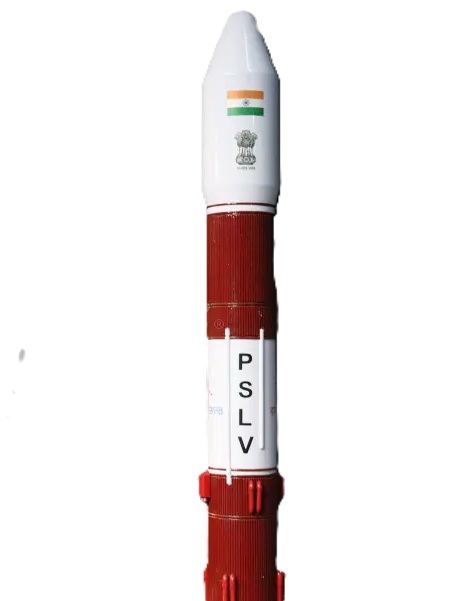🚀 The Polar Satellite Launch Vehicle (PSLV): India’s Trusted Workhorse in Space
India’s journey into the cosmos has been nothing short of remarkable. At the center of this celestial voyage stands the Polar Satellite Launch Vehicle (PSLV) – a reliable and versatile rocket that has powered India’s ascent in the global space industry. Developed by the Indian Space Research Organisation (ISRO), PSLV is often referred to as the “Workhorse of ISRO”, and for good reason.
In this blog, we delve into the origins, design, capabilities, and historic achievements of PSLV — a symbol of India’s technological prowess.
🌌 A Brief History of PSLV
The journey of PSLV began in the early 1980s, when ISRO identified the need for a more powerful and versatile rocket than its predecessor, the SLV (Satellite Launch Vehicle). After years of development, the PSLV successfully made its maiden flight on September 20, 1993. Though the first launch was not fully successful, it marked the beginning of a legacy that would eventually revolutionize satellite launches for India.
Since then, PSLV has completed 50+ successful missions, launching not only Indian satellites but also commercial payloads from multiple countries.
🛠️ Design and Configuration
PSLV is a four-stage rocket, using a combination of solid and liquid propulsion systems, making it uniquely flexible and powerful. Here’s a breakdown of its configuration:
-
First Stage (PS1)
-
Solid rocket motor (HTPB based)
-
Often aided by 6 strap-on boosters in PSLV-CA and PSLV-XL variants
-
-
Second Stage (PS2)
-
Liquid propulsion using Vikas engine (N₂O₄ and UDMH fuel)
-
-
Third Stage (PS3)
-
Solid propellant again, providing further push into orbit
-
-
Fourth Stage (PS4)
-
Twin liquid engines using MMH and MON-3
-
Allows for fine orbital adjustments
-
This mixed propulsion system enables PSLV to carry payloads ranging from 600 kg to 1,800 kg into Sun-synchronous polar orbits (SSO), Low Earth Orbits (LEO), and even Geostationary Transfer Orbits (GTO) in some cases.
🌍 Capabilities & Variants
PSLV’s adaptability has led to the creation of several versions:
-
PSLV-G (Generic) – The standard version with 6 strap-on boosters
-
PSLV-CA (Core Alone) – No strap-ons, for lighter payloads
-
PSLV-XL – Enhanced version with larger strap-ons for heavier missions
-
PSLV-DL, PSLV-QL – 2 or 4 strap-on boosters for mid-weight missions
-
PSLV-C series – Denotes specific mission launches (e.g., PSLV-C37)
The flexibility of configurations has made PSLV an attractive option for commercial satellite launches.
🛰️ Notable Missions & Achievements
🌟 1. PSLV-C37 (2017)
India set a world record by launching 104 satellites in a single mission, including Cartosat-2D and 103 nano-satellites from the U.S., Israel, Kazakhstan, and others.
🌕 2. Chandrayaan-1 (2008)
PSLV launched India’s first mission to the Moon, placing a lunar orbiter that made key discoveries like water molecules on the Moon’s surface.
🔴 3. Mangalyaan (Mars Orbiter Mission – 2013)
While the mission orbiter used PSLV-XL, it proved the vehicle’s capability to launch interplanetary missions, making India the first Asian nation to reach Mars orbit — and at a remarkably low cost.
🛰️ 4. Commercial Success
Through Antrix Corporation, ISRO’s commercial arm, PSLV has launched satellites for over 30 countries, making it a cost-effective option for small satellite operators worldwide.
📊 PSLV vs Other Launch Vehicles
| Feature | PSLV | GSLV | SLV/ASLV |
|---|---|---|---|
| Stages | 4 (Solid + Liquid) | 3 (Liquid + Cryo) | 1-2 stages |
| Max Payload (LEO) | ~3,800 kg (GTO: 1,410 kg) | ~5,000 kg (GTO) | <150 kg |
| Reliability | Very High | Moderate | Low |
| Cost Efficiency | Excellent | High | N/A |
| Key Missions | Chandrayaan, Mars, 104 satellites | INSAT, GSAT | Early R&D |
🔍 Why PSLV Matters
-
Affordable & Reliable: PSLV offers satellite launches at a fraction of the cost compared to other global space agencies.
-
Versatility: From Earth observation to planetary exploration, PSLV handles a wide range of missions.
-
Global Demand: Countries and private firms trust PSLV for commercial satellite deployment.
-
Make in India Symbol: It showcases India’s self-reliance in high-end technology and aerospace engineering.
🧠 What’s Next for PSLV?
As ISRO continues to develop more advanced launch vehicles like SSLV (Small Satellite Launch Vehicle) and Gaganyaan crew modules, PSLV is being adapted with new capabilities like re-startable fourth stages, multiple payload deployments, and orbital mission flexibility.
Moreover, its future may include reusable components and deeper collaboration with private space startups under India’s growing space ecosystem.
🚀 Conclusion
The PSLV is more than just a launch vehicle — it is a symbol of India’s ambition, innovation, and space leadership. As the nation continues to expand its footprint in space exploration, PSLV remains a cornerstone of this inspiring journey.
Whether launching a moon mission or deploying dozens of satellites across orbits, PSLV is undoubtedly India’s pride among the stars.

